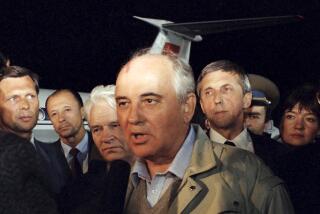First Kremlin Leader Ever to Visit Tokyo : Another test for Japan; another new worry for Washington
- Share via
One hundred years ago when Czar Nicholas II visited Japan as a young prince, he returned home with a nasty gash on his forehead, barely escaping death by assassination near Kyoto. Memories are as long in Moscow as the freezing winters, but Soviet President Mikhail S. Gorbachev hopes to take the long chill off Soviet-Japanese relations when he visits Tokyo next week.
Having initiated some bold, though not always successful, changes on the European front, Gorbachev is now turning to Soviet Asia. Under his leadership, Moscow has reached out to South Korea to establish trading ties. Soviet Foreign Minister Alexander A. Bessmertnykh was in Beijing last week to prepare for a Sino-Soviet summit next month. Now Gorbachev is extending a hand of friendship to Tokyo, in part to secure badly needed economic assistance.
TOKYO’S OPPORTUNITY: When Gorbachev steps onto Japanese soil, he will be the first Kremlin leader to visit Tokyo. His historic visit could be the first step toward rapprochement between Moscow and Tokyo. A major breakthrough is not expected, but meetings between Gorbachev and Japanese Prime Minister Toshiki Kaifu will be closely watched in the United States for its long-term implications for future U.S.-Japan relations. The visit will provide yet another opportunity to watch Tokyo give shape and focus to its emerging foreign policy, which was so roundly criticized during the Gulf crisis. Will Tokyo rise to the occasion?
A warming of relations between Moscow and Tokyo certainly is to be welcomed in the post Cold War world. Hostilities have existed between the two nations from the 1904-05 Russo-Japanese War through the Cold War. Resolving a long-standing territorial dispute over the four southernmost Kuril Islands has long been Tokyo’s condition for mending Soviet-Japanese relations. The Soviets have occupied the islands off of Hokkaido since 1945 and, as a result, the two countries have never signed a peace treaty.
The Japanese Foreign Ministry is insisting on the return of all four islands, but press reports indicate that Tokyo may settle for two. That could be achieved by following through on the 1956 agreement between Moscow and Tokyo that called for the return of two islands. That exchange never occurred because of the tightening grip of the Cold War and the 1960 U.S.-Japan security agreement, which allows U.S. forces to be stationed in Japan.
The islands are of inconsequential strategic and economic value but they symbolize the mistrust between Moscow and Tokyo. If Gorbachev and Kaifu do not strike any bold deal on the islands, it will be because they both are in political trouble at home. (One problem: The disputed islands are part of Gorbachev rival Boris Yeltsin’s Russian republic.)
WASHINGTON’S WORRY: Another possible item on Gorbachev’s agenda is the long-standing Soviet desire to move “toward a new security structure” in Asia. He raised the issue in a recent interview, carefully noting that Moscow and Washington would be “indispensable participants” in any new arrangement. This is particularly troublesome to U.S. policy makers: Two close allies, Canada and Australia, have over the past year also proposed forming a new security arrangement in Asia, akin to the Conference on Security and Cooperation in Europe. Such a regrouping would be at odds with U.S. interests, notably the Japan-U.S. Security Treaty, a cornerstone of U.S.-Japan bilateral relations.
Tokyo will have to work smart in order not to play second fiddle to the adroit Gorbachev with his enormous force and charm on foreign policy matters. He has used past foreign visits to unveil new initiatives. Tokyo’s big challenge will be to hold its own and not be cowed into following a Soviet agenda for the Asia-Pacific region.
More to Read
Sign up for Essential California
The most important California stories and recommendations in your inbox every morning.
You may occasionally receive promotional content from the Los Angeles Times.










